
We got up before 6am today and took a taxi to Kagoshima port, opposite which Mount Sakurajima was getting angry as the sun rose, spitting up huge plumes of smoke. Sakurajima is made from such black volcanic rock that the sun's rays don't seem to illuminate at all, and so it sits on the horizon across the water from the port sheathed in ominous shadows and belching out black smoke while the local townsfolk just happily get on with their lives (while they still can).
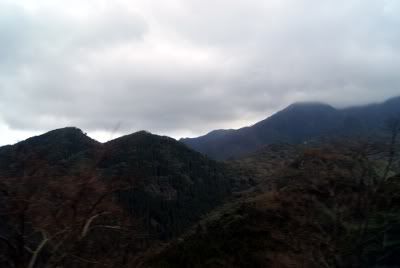
We boarded the morning's first boat to Yakushima, a small sub-tropical island 100km from the tip of Kyushu. As we arrived we saw that most of the island is completely undeveloped, the boat pulling in to a small harbour settlement sitting at the foot of a mass of tall rounded mountains covered in dense forest. With the assistance of a cheerful lady in the tourist office – who was baffled by the idea we had only come to Yakushima for a day-trip – we worked out a hiking trail we could complete within six hours and still make it back in time for the last ferry.
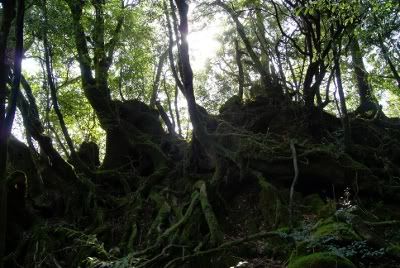
A taxi took us winding up into the mountains to an altitude of 800 metres and dropped us off at the gates to the Shiratani Unsuikyo Natural Recreation Forest. After paying £2 a head, we followed a trail along a stream and series of waterfalls, before turning up-hill into the forest, following a series of occasional pink ribbons tied to the trees along a natural pathway supplemented where necessary by whatever rocks, logs and roots the park rangers found to hand.
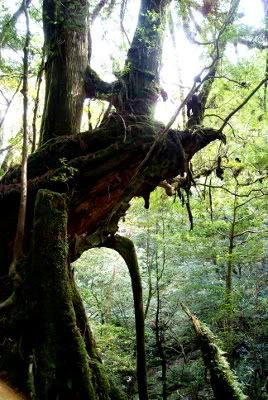
The ancient forest is purposefully kept natural and unmanaged, and comprises a mix of wildly overgrown primeval forest – dominated by grand cedar trees, some over five thousand years old – and an accompanying freak show of the survivors of mutilation. While these latter trees were also thousands of years old, they had been chopped down to their stumps centuries ago to make roof shingles, left to become “second generation” cedars, regrowing with numerous twisted and exotic trunks and bulbous masses of branches. The local people are almost as proud of these fantastical old monstrosities as they are the grand trees which have survived untouched.
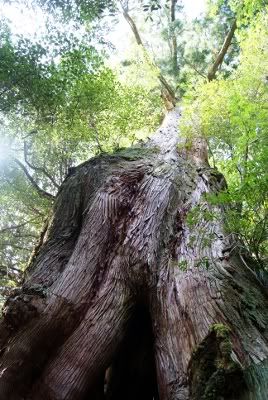
Kagoshima is the rainiest place in Japan (although it was clear and blue while we were there), and the sub-tropical weather has created an ecosystem very favourable to exotic ferns and rare mosses. In fact, moss covers absolutely everything, and the bark of many trees was long lost under a springy carpet of green, giving the wildly overgrown forests a pleasingly dark and lush feel which apparently inspired the imagery in Studio Ghibli's movie Princess Mononoke (although neither of us has seen it). The whole place felt magical and isolated, and we met only two other people the whole time we were in the forest, along with a couple of young deer feeding on moss by the track, and a small family of monkeys sunbathing on the roadside.
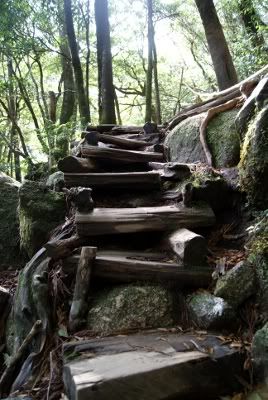
The last ferry to leave the island was at 3:45pm, but even in such a short time we both agreed it was the best thing we'd seen so far in Japan. There are so many other trails to take on the island – with an ecosystem that changes from tropical to temperate as you climb higher – that you could spend four or five happy days exploring Yakushima. In a few years' time, I think we'll probably put Yakushima at the centre of another trip to the Far East (albeit timed for warmer weather).
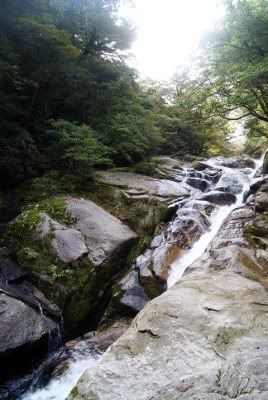
It took three hours to get back onto Kyushu, where we had sushi off the conveyor belt (an assured way to get what you want where no English is spoken) at Dolphin Port, before retiring to the hotel for another soak in the hot spa and then bed.




No comments:
Post a Comment